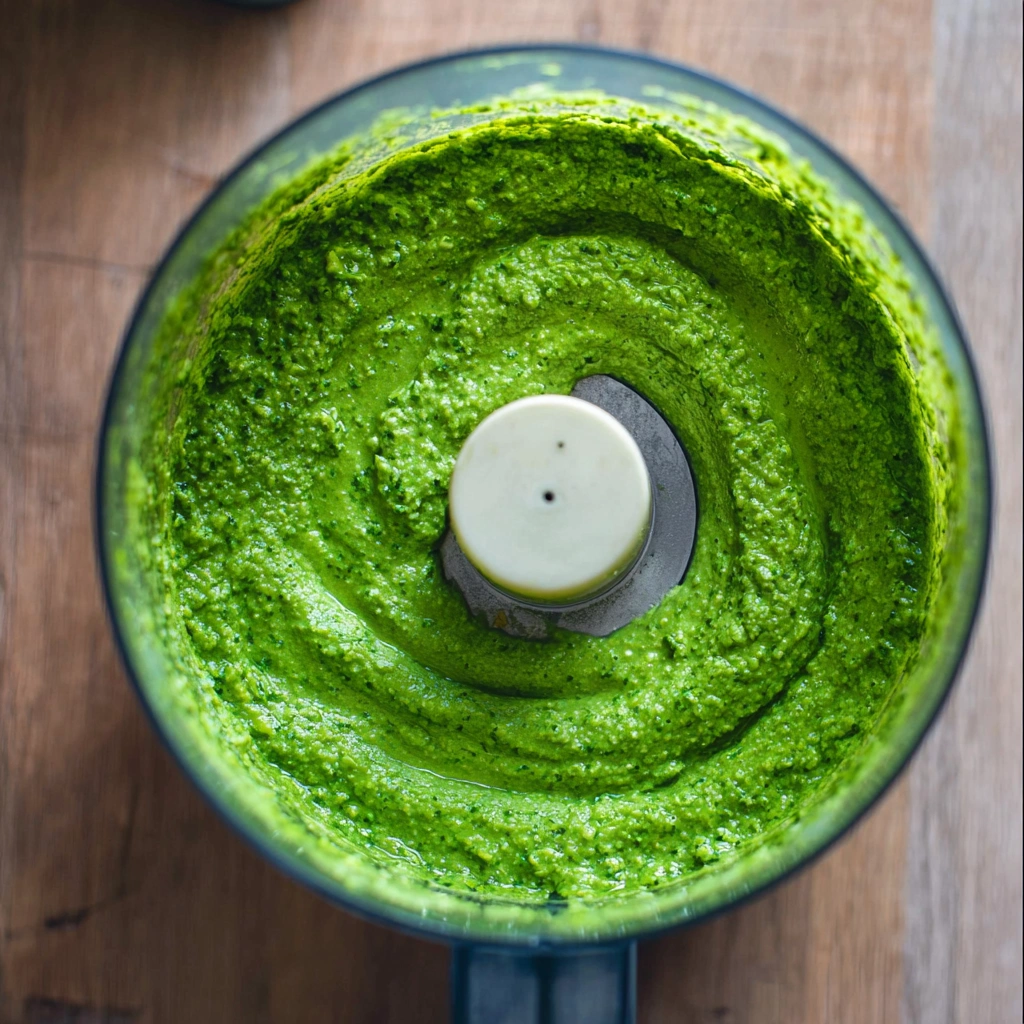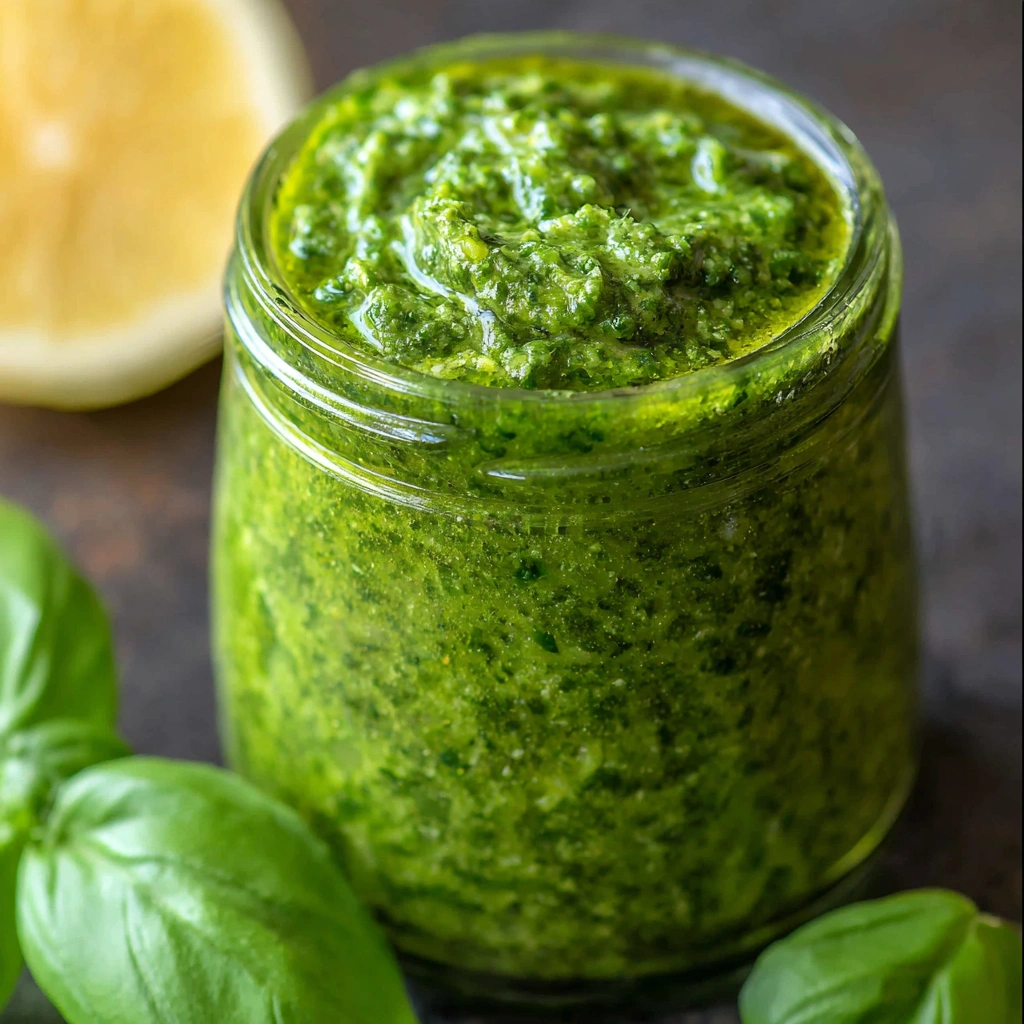This Basil Pesto Recipe is a celebration of fresh, simple ingredients blended into a vibrant green sauce that transforms everyday dishes into something extraordinary. Made in just minutes, this classic Italian condiment combines sweet basil leaves, rich olive oil, sharp Parmesan cheese, and toasty pine nuts with a hint of garlic and a splash of lemon juice for brightness.
Whether you’re tossing it with pasta, spreading it on a sandwich, or dolloping it over grilled meats, homemade pesto adds a burst of flavor that store-bought versions just can’t match.
Why You’ll Love This Basil Pesto
- Quick and Easy: Ready in under 10 minutes with a food processor.
- Customizable: Swap nuts, change herbs, or adjust seasoning to your taste.
- Fresh & Bright: The lemon juice enhances the basil and helps preserve the color.
- Freezer-Friendly: Make a large batch and freeze in portions for future meals.
Ingredients You’ll Need
- 2 cups fresh basil leaves, tightly packed
- ¾ cup shredded Parmesan cheese (or Pecorino Romano)
- ½ cup extra-virgin olive oil
- ½ cup pine nuts
- 2 large garlic cloves
- ¼ cup fresh lemon juice (from 1 large or 2 small lemons)
- ½ teaspoon salt, or to taste
- ¼ teaspoon ground black pepper
Step-by-Step Instructions
Step 1: Prep Your Ingredients
Start by rinsing your basil leaves gently under cold water. Shake off the excess moisture, then dry the leaves thoroughly. A salad spinner works great here. Removing water helps preserve the flavor and prevents the pesto from becoming watery.
Peel the garlic cloves, and juice your lemons until you get a full ¼ cup of juice.
Step 2: Toast the Pine Nuts (Optional, but Recommended)
Place your pine nuts in a dry skillet over medium heat. Stir frequently for about 2–3 minutes until they become golden and aromatic. Be careful not to burn them. Toasting brings out a deeper, nuttier flavor.
Let them cool slightly before adding them to your food processor.
Step 3: Add Everything to the Food Processor
Into your food processor bowl, add:
- The basil leaves
- Parmesan cheese
- Toasted pine nuts
- Garlic cloves
- Lemon juice
- Salt and pepper
Pulse a few times to start breaking everything down.

Step 4: Drizzle in the Olive Oil
With the food processor running on low speed, slowly drizzle in the olive oil through the top feed tube. Blend until the mixture is smooth but still has a bit of texture. You don’t want it to be a paste—pesto should have some body and character.
Stop and scrape down the sides as needed to make sure everything is well incorporated.

Step 5: Taste and Adjust
Taste the pesto. If it needs more brightness, add a splash more lemon juice. If you like it saltier, add a pinch more salt. Some people prefer a stronger garlic flavor—adjust based on your personal preference.
How to Use Basil Pesto
There are endless ways to use your homemade basil pesto. Here are some favorites:
- Pasta: Toss with hot cooked pasta for a fast and flavorful meal.
- Pizza: Use as a base sauce or drizzle over baked pizza for added zing.
- Sandwiches: Spread it on grilled cheese, chicken sandwiches, or wraps.
- Salads: Thin it with a little more olive oil or vinegar and use it as a dressing.
- Grilled Meats: Spoon over grilled chicken, steak, or fish just before serving.
- Vegetables: Mix into roasted or steamed vegetables for added flavor.
Storage Instructions
In the Fridge: Store pesto in an airtight jar or container. Pour a thin layer of olive oil on top to prevent oxidation. It will stay fresh in the fridge for up to 1 week.
In the Freezer: For longer storage, freeze pesto in ice cube trays. Once frozen, transfer the cubes to a zip-top freezer bag. This makes it easy to grab just the amount you need. Frozen pesto lasts up to 3 months.
To use, let it thaw at room temperature or gently reheat in a pan over low heat.
Tips & Variations
- Nut Substitutes: Try walnuts, almonds, or pistachios if you don’t have pine nuts.
- Cheese Options: Pecorino Romano adds a saltier, tangier flavor than Parmesan.
- Herb Mixes: Add parsley, arugula, or mint for a unique twist.
- No Food Processor? Use a mortar and pestle for a traditional approach with rustic texture.

